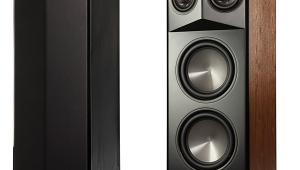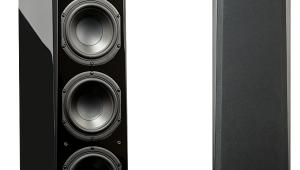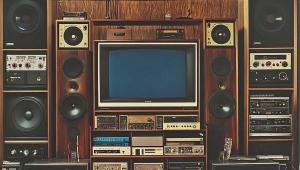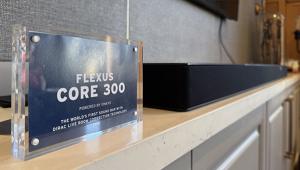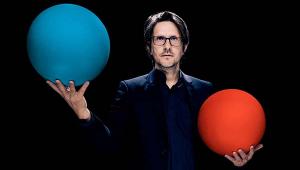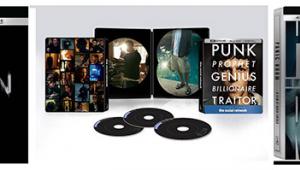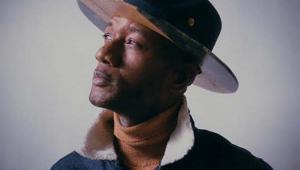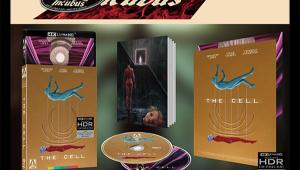Or, you could nab a set of Magnepan LRS for a grand, maybe add in a 300 buck sub, and there you go. Plus, I think the Maggies look better to! White Bear Lake , Minnesotas finest product! Gotta love American made stuff that sells for a fair price, you just gotta!
Diptyque DP 115 Speakers Review: Planar-Magnetic Attraction

AT A GLANCE
Plus
Exquisitely detailed sound
Exceptional imaging
Excellent bass for a dipole planar speaker
Modern aesthetics
Easy to assemble
Neighbor-friendly
Minus
Pricey
Power hungry
Dipoles are not for everyone
Limited optimal listening area
Could use a sub for some applications
THE VERDICT
These revealing, sublime-sounding speakers elevated listening sessions to a higher level of audiophile enjoyment than any pair I have reviewed before.
The Diptyque DP 115 speakers are a new model 2-way, ribbon, and planar magnetic driver dipole “isodynamic” speaker system designed and built in France. I encountered the pair at AXPONA 2024 and instantly fell in love with their looks and their sound. They are notable not only for their unique design—it is one of five models from the company that feature the same technology and aesthetic—but also for their exceptional performance. As someone who has reviewed many traditional “cone and dome” speaker models over the years, I found these Diptyques delivered a thrilling listening experience that set them apart from much of what I have heard at any price. They are high-end, high-performance speakers.
.jpg)
Design and Sound Characteristics
In addition to being flat, the Diptyque DP 115s are dipole speakers, meaning the driver projects sound to both the front and rear simultaneously. This creates a figure-eight sound dispersion pattern because there is inherently noise cancellation on the sides of the speaker as the front and rear sound waves meet. This is particularly noticeable at bass frequencies, which are omnidirectional in nature. However, this quality is a good match for the ribbon tweeter, which does not suffer cancellation but still manages to match the dispersion of the mid/bass driver due to its inherent directionality.
If you stand to the side of these speakers and no subwoofer is in use, the sound may seem thinner and lacking in bass. That is completely normal for a dipole. However, when seated in the sweet spot, the audio quality is impeccable, with a balanced and rich frequency response, tight, powerful bass, no cabinet or horn coloration, and less influence from the room itself than you’d hear with many speakers. It’s a clean, pure sound that pays full respect to the source material.
Aesthetic appeal is another strong suit of the DP 115s. The Diptyques have a unique look. Their stylish, flat, minimalist design works great in modern living spaces, making them as much a visual treat as they are an auditory marvel. Their minimalist, rectangular design fits perfectly within my IKEA-furnished loft, complementing the overall black-and-white theme. When flanking my 77-inch Samsung Quantum Dot OLED TV, they not only look great but also enhance the AV experience by delivering a focused and hyper-clear phantom center for dialogue.
.jpg)
The key to getting bass out of a dipole is surface area, both of the driver and the speaker baffle. A larger baffle decreases the cancellation effect. The rated response of the DP 115s is 40 Hz to 22 kHz, which is respectable and covers most music genres fully, while also offering enough extension to seamlessly add a sub.
The axiom for bass reproduction will always be “there is no replacement for displacement,” which is to say, you have to move air! And this is the best trick these speakers offer; they move more air than you’d normally expect from a planar-magnetic design. When listening, you wind up wondering where they hid the woofer. Of course, there is no woofer. While the dimensions of each speaker are 47.44 x 18.7 x 11.81 inches, that factors in the base. The speaker itself is only 0.86 inches thick, but make no mistake—it is also super rigid and free of resonances because it is made of two sheets of solid steel that sandwich the drivers.
.jpg)
Placement and Setup
Dipole speakers like the DP 115s need some space to perform optimally. They are not suitable for placement against walls; a few feet of space is required. For urban dwellers like myself, the figure-eight dispersion is advantageous. In my loft, the reduced bass projection beyond the immediate listening area minimizes the risk of disturbing neighbors, allowing for higher volume listening without excessive bass transmission outside the apartment. But there is also an audiophile benefit: side wall reflections are significantly reduced as compared to traditional speakers. That means you hear more of the direct sound from the speakers (i.e., what’s in the original recording) and less of the room’s reverb.
.jpg)
While there are placement considerations, in my loft’s living room area, these speakers simply went where I usually place any other speakers, which is to say about three feet from the front wall, roughly eight feet apart, flanking a 77-inch TV, with the sofa about ten feet back. Because of the shallow depth of these flat speakers, the front baffles stick no further out than would a pair of tower speakers placed two feet from the front wall. The lack of a traditional box design means there’s no box coloration, contributing to their clean and undistorted sound. Another benefit to the dipole dispersion pattern is that thanks to the side-cancellation effect, there is less interaction not just between the speakers and the side walls, but also the TV screen.
I have a TV perfectly centered between the speakers. Except for when I do reviews of multichannel speakers, I prefer (and depend) on a phantom center for video dialog because it puts the voices where they should be, coming directly from the TV screen.
The rated sensitivity of 86dB/1W/1m is low for a full-sized speaker, so you do need a robust amp to power them at higher output levels. Power handling is rated at 150 W with 6 ohm impedance. That means when fully powered, each speaker offers up to 108dB of output. A Primare SP25 pre/pro handled the processing. For power, I used a Primare A35.8 running in bridged mode, which is overkill given the 750W/channel output (but it’s always good to have the headroom).
I ran Dirac Live room correction on the speakers. With these speakers, I prefer the unaltered sound, so I only applied correction to the bass region, where the room is the main influence, and also to integrate a sub (a Perlisten R18S). When I used the sub, I crossed over at 80 Hz. For some of my listening, I also used a pair of GoldenEar Triton 7 speakers as surrounds to create a 4.1-channel listening experience.
The music came from Tidal streaming through Roon (CD quality or higher), but also via iTunes using an Apple TV 4K as the player, streaming at 256 kbps as Apple does. I also watched movies with the Apple TV 4K as well as through a Sony UHD Blu-ray player. Gaming was with a PlayStation 5.
Performance
In an AV context, the DP 115s excel by producing a clear and precise phantom center. Sitting anywhere on my sofa, I found no need for a dedicated center channel because the imaging puts the phantom center right where it should be, floating between the two speakers. This is particularly useful for someone like me who doesn’t favor center channels for aesthetic reasons and because having voices come from below a TV screen is not natural. In fact, I am perfectly happy to use a 2.1 setup for watching movies, as long as the speakers are top notch. I find in many cases that 4.1 is all I need for complete immersion and that is what I used for movies and video games.
With the DP 115s, dialogue clarity with movies and TV is impeccable, with every word coming through, even during intense scenes with lots of background noise like in Furiosa or Civil War, two of the movies I watched using these speakers. Same goes for sports; it’s almost comical how much detail I could hear in the audio mix during the NBA finals.
The speakers’ audiophile qualities extend to various media types, including gaming, live sports, and music. The precise imaging allows for a detailed soundstage where individual sound objects are easily discernible, enhancing the overall experience. This extends into the world of video games, where perhaps it is no coincidence that planar-magnetic headphones are currently all the rage—Sony bought Audeze—thanks to the precision that they offer. Well, same thing here. The soundscapes and effects in Red Dead Redemption 2—along with the soundtrack—make it as thrilling to listen to as a movie.
The bottom line is these are not speakers that you would use to build out a huge gazillion channel Atmos home theater system. But they are speakers that I would personally choose for a well-considered living room surround system, either pure stereo, or else with just enough surround channels to complement the excellence of the DP115s.
Music Listening
The responsiveness of the ribbon drivers in the DP 115s is remarkable. They deliver texture and resolution in spades. The dynamics achieved make for compelling listening that has a live feel to it. These speakers are addictive to listen to and boosted my enthusiasm for proper, perfectly centered “deep listening.” Their ability to produce clean, pure sound and get the most out of any recording made playing full albums both a pleasure and an exploration.
If a song possesses a deeply layered, sophisticated mix, that’s what comes through. If the music is clean and simple, that’s what you get.
Streaming The Temple of I & I by Thievery Corporation through Tidal on a Saturday evening, at volume levels you can feel, is a delightful listening session. The track “Strike the Root,” which is essentially mixed in mono, maintains focus. All the sounds emanate from a floating spot in the center, rendered with holographic precision. I easily heard details often obscured by other, lesser speakers. Based on what I know, the ability to handle mono audio with such aplomb is a testament to the speakers’ superior phase relationship between the drivers.
Tracks on the album with more complex, expansive stereo mixes, like “True Sons of Zion,” demonstrate the Diptyque 115s’ prowess in creating an enveloping soundstage. The speakers wrap the listener in a well-rendered stereo field, making the listening experience deeply satisfying. And then there are albums mixed to intentionally produce 3D sound from just two speakers. A classic is The Orb’s Adventures Beyond the Ultraworld. For 30 years I’ve been queueing up the track “Outlands” with its opening that starts with thunder cracking and some synth sounds, but then comes the jet engine sounds and the whoosh that does circles around your head—if your system is up to snuff (and that simple effect impresses me to this day).
.jpg)
Another masterful recording from the early 90s is “Riverz End” from Skinny Puppy’s industrial masterpiece, Last Rights. Here, the sound effects seem to come right at you, seemingly totally detached from the speakers, each audio “object” within the mix is tangible in terms of its size and position.
I admit to not listening to a lot of orchestral music aside from what’s found in movies. But that is partly because of how disappointing it often is when a speaker can’t handle the complex and dynamically demanding sound of an orchestra. So for once in a review, I went for it and blasted some Beethoven—Ninth Symphony, Leonard Bernstein conducting. I’ll put it as plainly and bluntly as I can: I don’t usually review speakers that are able to handle classical music properly, but the DP 115s most certainly ace it. Also, this is where I want to highlight the value of upgrading these speakers to a 2.1 system. With the Perlisten sub in the mix it was magical; the 18-incher added an impeccably solid foundation. Every now and then you could feel it; there’s some surprising deep bass effects in the recording.
But it’s what the speakers achieved while building upon the sub’s foundation that truly impressed me, with each instrument ringing true in tone and texture. It brought home the emotion, like a dose of Ludwig always does. Boy, did I get goosebumps during that listening session!
And then there’s my favorite test of a system’s mettle. “Disc Wars” from the Tron Legacy soundtrack by Daft Punk opened up when played through the DP 115s, revealing previously hidden nuances that are aural Easter eggs for attentive listeners. Here the big trick is separating the orchestra from the epic bass that dominates the track. The cleanliness of the DP 115 bass allowed it to flow right into the Perlisten, for what I’d call truly seamless integration. This may well be the best rendition of the track I have ever achieved, albeit only with the help of the sub.
Sticking with the 90s theme and looking for simplicity and beauty in a song, I played “Sweet Jane” from The Trinity Session. Perfect. ‘Nuf said.
Measurements
I’m not able to provide measurements that can compete with a Klipper scanner or an anechoic chamber, so for the chart fans out there, I hope someone posts “spins” of these. I’m sure it’ll be interesting. Still, I did run a few sweeps with REW (Room EQ Wizard) and what I saw matched up well with the rated response; bass genuinely gets down to 40 Hz and extends past 20 kHz. I also liked the shape of the response curve, relative to what I have seen from other speakers in the same room, and what it speaks to is a tight integration of the two drivers.
One thing I can measure with absolute certainty is impedance. I can confirm it is fundamentally a 6-ohm speaker; it does not go below 5.8 ohms. The impedance does reach a peak of 9 ohms at the crossover point, but quickly (and smoothly) drops back down to 6.4 ohms. From an impedance standpoint, it is a very amplifier-friendly speaker.
.jpg)
Conclusion
First, the caveats. Unsurprisingly, high-performance sound comes at a cost. That cost is literal; the MSRP of $12K is the highest of any speakers I have reviewed for this magazine. You also need to have a beefy amp to drive these speakers properly, a bargain AVR will not do the trick. So, you have to invest in speakers and power. Plus, the 40 Hz extension is pretty much determined by the laws of physics, so if you want to play deeper you need a sub that can keep up with speakers of this quality, representing another sizable investment.
But if you do take that path, the reward is tremendous. In previous issues, I have discussed how I have begun to weigh the benefits of fewer but better channels versus adding ever more speakers to a system. These days, a 13.4.6 system is doable with a high-end AVR. But the bottom line is maxing out an AVR like that costs even more than buying a nice stereo, and yet these days even high-end 2-channel gear accommodates eARC and streaming, so it really is OK to put a pair of awesome speakers in your living room, use them for everything, and call it a day.
In conclusion, the DP 115 speakers are an exceptional choice for audiophiles and AV enthusiasts who appreciate detailed, clear, and responsive sound. While their dipole design and figure-eight dispersion pattern may not suit every room layout, particularly those seeking consistently loud sound throughout an open-plan space, they excel in dedicated listening areas. Their aesthetic appeal, combined with their impressive performance across different media, makes them an excellent speaker option to any high-end audio setup.
SPECS
- Log in or register to post comments


Sony speakers are also good, crispy sound
https://www.freaksclothingshop.com/collections/men
mens gothic clothing

Nice article
hope to purchase this
Here is the link for free korean dramas https://blogul-lui-gian.com/

Can't you guys describe the speaker correctly?????????????????
IT IS A BIPOLE NOT A DIPOLE!!!!!!!!!!!!!!
When ONE driver produces sound front and back it is a BIPOLE!!!
When TWO drivers produce sound front and back it is a DIPOLE!!!!!!!!!
How hard is to look up the definition of DIPOLE?
Another over-priced speaker!!
I built my own BIPOLES using GRS midrange and tweeter planars that can go far louder, more efficient and the dual opposing 12" woofers provide subwoofer lows with less less distortion.
Friends who have heard them are floored - everyone of my audio buddies!
How much did they cost to build? Less than $2K per pair!!!!!!!!!!

Hey, do you think you can help me with some questions about this build?
Audio enthusiest but would really like to try my hand at building something quality. Would love to get in touch. Feel free to email me at f7wnrx5qmp@privaterelay.appleid.com (This is a private relay to my email through Apple Icloud+). Hope to hear from ya!
Thanks!
Jeff

These speakers create an immersive experience, with the isodynamic ribbon and planar magnetic drivers delivering a level of clarity, depth, and responsiveness that redefines what’s possible in audio. The open, dipole configuration allows for an incredibly natural soundstage, enveloping listeners in rich, precise tones that make each note feel alive.
Regards
https://stylo.pk















